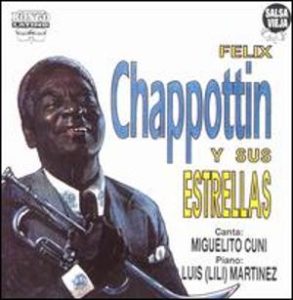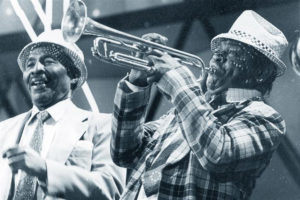 FÉLIX CHAPPOTTÍN, MÚSICO, DIRECTOR DE ORQUESTA Y COMPOSITOR. VIDEOS
FÉLIX CHAPPOTTÍN, MÚSICO, DIRECTOR DE ORQUESTA Y COMPOSITOR. VIDEOS
Félix Chappottín Lage nació el 31 de marzo de 1907, en el barrio de Cayo Hueso, La Habana. Fue trompetista y líder de banda cubano y miembro de tres bandas cubanas de gran éxito: Septeto Habanero, el conjunto de Arsenio Rodríguez y Conjunto Chappottín, que dirigió.
Su padre Julio Chappottin era miembro del grupo de Son ‘Los Apaches’. Félix a los 8 años de edad, comenzó a estudiar corneta con Venancio González; luego tomó la tuba, el oboe y el euphonium. A los doce años se unió a la banda juvenil local de Guanajay.
https://youtu.be/StPdBsPXGww
En 1924 se unió a la Estudiantina Orquídea de Américo González como trompetista, y en 1927, se unió al Septeto Habanero, anteriormente Sexteto Habanero, convirtiéndose en el trompetista más famoso de Cuba. Con el Habanero, Chappottín grabó varios sencillos de 78 rpm para Víctor entre febrero de 1928 y 1930, cuando dejó la banda por razones económicas, fue reemplazado por José Interián. Luego se unió a otros septetos hijos: Colín, Munamar (dirigido por Juan José Izquierdo), Agabama y Universo (dirigido por Abelardo Barroso). Después de la disolución de Sexteto Boloña en 1935, Chappottín y Jesús “Tata” Gutiérrez fundaron el Sexteto Bolero. En 1939 se unió al septeto Carabina de Ases.
FELIX CHAPPOTTIN Y SUS ESTRELLAS .
En la década de 1940, después de la disolución de Carabina de Ases, Chappottín se unió a varios conjuntos: América, Gloria Cubana, Anacaona (dirigida por Concepción Castro), Azul (dirigida por Chano Pozo), Los Jóvenes del Cayo y finalmente en 1950 con el popular Arsenio Rodríguez. conjunto En 1950, Arsenio Rodríguez decidió continuar su carrera en Nueva York y los miembros de su conjunto que permanecieron en La Habana fundaron el Conjunto Chappottín, dirigido por Chappottín, con los arreglos de la pianista Lilí Martínez y presentando a Miguelito Cuní en la voz principal. La banda se convirtió en uno de los conjuntos más populares de la década de 1950 con éxitos como “Alto Songo”.
https://youtu.be/yA-Vg8W9ncI
Chappottín siguió siendo el líder de su conjunto hasta su muerte, que tuvo lugar el 21 de diciembre de 1983 en La Habana.
Chappottín es ampliamente considerado como el fundador del estilo moderno de trompeta cubana debido a su enfoque innovador en el desarrollo del hijo Cubano entre 1920 y 1950. Según Craig Harris, escritor de AllMusic, Chappottín “continuó inspirando la música afrocubana con su dulce trompeta tocando durante más de seis décadas”. En 2002, Chappottín fue inducido póstumamente al Salón de la Fama de la Música Latina Internacional.
Después de su muerte, su hijo y más tarde su nieto han dirigido Conjunto Chappottín.
 FÉLIX CHAPPOTTÍN, MUSICIAN, BANDLEADER, AND SONGWRITER. VIDEOS.
FÉLIX CHAPPOTTÍN, MUSICIAN, BANDLEADER, AND SONGWRITER. VIDEOS.
Félix Chappottín Lage was born on March 31, 1907, in the barrio of Cayo Hueso, La Havana. He was a Cuban trumpeter and bandleader and a member of three highly successful Cuban bands: Septeto Habanero, Arsenio Rodríguez’s conjunto, and Conjunto Chappottín, which he directed.
His father Julio Chappottin was a member of the son group Los Apaches. Felix at 8 years of age, began to study cornet under Venancio González; he later took up the tuba, the oboe, and the euphonium. At age twelve he joined the local youth band of Guanajay.
In 1924 he joined the Estudiantina Orquídea de Américo González as a trumpeter, and in 1927, he joined the Septeto Habanero, previously the Sexteto Habanero, becoming the most famous trumpeter in Cuba. With the Habanero, Chappottín recorded several 78 rpm singles for Victor between February 1928 and 1930, when he left the band for economic reasons, was replaced by José Interián. He then joined other son septets: Colín, Munamar (directed by Juan José Izquierdo), Agabama, and Universo (directed by Abelardo Barroso). After the disbandment of Sexteto Boloña in 1935, Chappottín and Jesús “Tata” Gutiérrez founded the Sexteto Bolero. In 1939 he joined the septet Carabina de Ases.
FELIX CHAPPOTTIN AND HIS STARS.
In the 1940s, after the disbandment of Carabina de Ases, Chappottín joined several conjuntos: América, Gloria Cubana, Anacaona (directed by Concepción Castro), Azul (directed by Chano Pozo), Los Jóvenes del Cayo and finally in 1950 with Arsenio Rodríguez’s popular conjunto. In 1950, Arsenio Rodríguez decided to continue his career in New York and the members of his conjunto that remained in Havana founded Conjunto Chappottín, which was directed by Chappottín, with the arrangements of pianist Lilí Martínez and featuring Miguelito Cuní on lead vocals. The band became one of the most popular conjuntos of the 1950s with hits such as “Alto Songo”.
Chappottín remained the leader of his conjunto until his death, which took place on December 21, 1983, in Havana.
Chappottín is widely regarded as the founder of the modern Cuban trumpet style due to his innovative approach in the development of son Cubano between 1920 and 1950s. According to Craig Harris, writer for AllMusic, Chappottín “continued to inspire Afro-Cuban music with his sweet-toned trumpet playing for more than six decades”. In 2002, Chappottín was posthumously inducted into the International Latin Music Hall of Fame.
After his death, his son and later his grandson have directed Conjunto Chappottín.
Agencies/ Wiki/ Felix Chappottin Bio./ Internet Photos/ YouTube/ Arnoldo Varona/ www.TheCuban History.com
THE CUBAN HISTORY, HOLLYWOOD.








